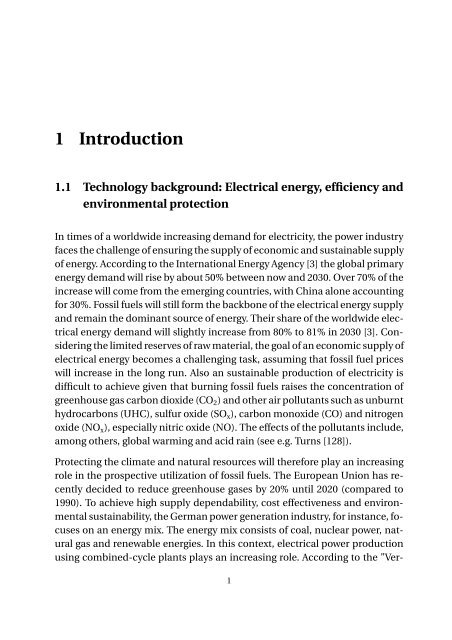Impact of fuel supply impedance and fuel staging on gas turbine ...
Impact of fuel supply impedance and fuel staging on gas turbine ...
Impact of fuel supply impedance and fuel staging on gas turbine ...
You also want an ePaper? Increase the reach of your titles
YUMPU automatically turns print PDFs into web optimized ePapers that Google loves.
1 Introducti<strong>on</strong><br />
1.1 Technology background: Electrical energy, efficiency <str<strong>on</strong>g>and</str<strong>on</strong>g><br />
envir<strong>on</strong>mental protecti<strong>on</strong><br />
In times <str<strong>on</strong>g>of</str<strong>on</strong>g> a worldwide increasing dem<str<strong>on</strong>g>and</str<strong>on</strong>g> for electricity, the power industry<br />
faces the challenge <str<strong>on</strong>g>of</str<strong>on</strong>g> ensuring the <str<strong>on</strong>g>supply</str<strong>on</strong>g> <str<strong>on</strong>g>of</str<strong>on</strong>g> ec<strong>on</strong>omic <str<strong>on</strong>g>and</str<strong>on</strong>g> sustainable <str<strong>on</strong>g>supply</str<strong>on</strong>g><br />
<str<strong>on</strong>g>of</str<strong>on</strong>g> energy. According to the Internati<strong>on</strong>al Energy Agency [3] the global primary<br />
energy dem<str<strong>on</strong>g>and</str<strong>on</strong>g> will rise by about 50% between now <str<strong>on</strong>g>and</str<strong>on</strong>g> 2030. Over 70% <str<strong>on</strong>g>of</str<strong>on</strong>g> the<br />
increase will come from the emerging countries, with China al<strong>on</strong>e accounting<br />
for 30%. Fossil <str<strong>on</strong>g>fuel</str<strong>on</strong>g>s will still form the backb<strong>on</strong>e <str<strong>on</strong>g>of</str<strong>on</strong>g> the electrical energy <str<strong>on</strong>g>supply</str<strong>on</strong>g><br />
<str<strong>on</strong>g>and</str<strong>on</strong>g> remain the dominant source <str<strong>on</strong>g>of</str<strong>on</strong>g> energy. Their share <str<strong>on</strong>g>of</str<strong>on</strong>g> the worldwide electrical<br />
energy dem<str<strong>on</strong>g>and</str<strong>on</strong>g> will slightly increase from 80% to 81% in 2030 [3]. C<strong>on</strong>sidering<br />
the limited reserves <str<strong>on</strong>g>of</str<strong>on</strong>g> raw material, the goal <str<strong>on</strong>g>of</str<strong>on</strong>g> an ec<strong>on</strong>omic <str<strong>on</strong>g>supply</str<strong>on</strong>g> <str<strong>on</strong>g>of</str<strong>on</strong>g><br />
electrical energy becomes a challenging task, assuming that fossil <str<strong>on</strong>g>fuel</str<strong>on</strong>g> prices<br />
will increase in the l<strong>on</strong>g run. Also an sustainable producti<strong>on</strong> <str<strong>on</strong>g>of</str<strong>on</strong>g> electricity is<br />
difficult to achieve given that burning fossil <str<strong>on</strong>g>fuel</str<strong>on</strong>g>s raises the c<strong>on</strong>centrati<strong>on</strong> <str<strong>on</strong>g>of</str<strong>on</strong>g><br />
greenhouse <strong>gas</strong> carb<strong>on</strong> dioxide (CO 2 ) <str<strong>on</strong>g>and</str<strong>on</strong>g> other air pollutants such as unburnt<br />
hydrocarb<strong>on</strong>s (UHC), sulfur oxide (SO x ), carb<strong>on</strong> m<strong>on</strong>oxide (CO) <str<strong>on</strong>g>and</str<strong>on</strong>g> nitrogen<br />
oxide (NO x ), especially nitric oxide (NO). The effects <str<strong>on</strong>g>of</str<strong>on</strong>g> the pollutants include,<br />
am<strong>on</strong>g others, global warming <str<strong>on</strong>g>and</str<strong>on</strong>g> acid rain (see e.g. Turns [128]).<br />
Protecting the climate <str<strong>on</strong>g>and</str<strong>on</strong>g> natural resources will therefore play an increasing<br />
role in the prospective utilizati<strong>on</strong> <str<strong>on</strong>g>of</str<strong>on</strong>g> fossil <str<strong>on</strong>g>fuel</str<strong>on</strong>g>s. The European Uni<strong>on</strong> has recently<br />
decided to reduce greenhouse <strong>gas</strong>es by 20% until 2020 (compared to<br />
1990). To achieve high <str<strong>on</strong>g>supply</str<strong>on</strong>g> dependability, cost effectiveness <str<strong>on</strong>g>and</str<strong>on</strong>g> envir<strong>on</strong>mental<br />
sustainability, the German power generati<strong>on</strong> industry, for instance, focuses<br />
<strong>on</strong> an energy mix. The energy mix c<strong>on</strong>sists <str<strong>on</strong>g>of</str<strong>on</strong>g> coal, nuclear power, natural<br />
<strong>gas</strong> <str<strong>on</strong>g>and</str<strong>on</strong>g> renewable energies. In this c<strong>on</strong>text, electrical power producti<strong>on</strong><br />
using combined-cycle plants plays an increasing role. According to the ”Ver-<br />
1
















